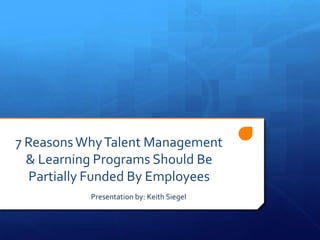
7 reasons why talent management & learning programs should be partially funded by employees
- 1. 7 Reasons Why Talent Management & Learning Programs Should Be Partially Funded By Employees Presentation by: Keith Siegel
- 2. Overview Employees across the nation help insure themselves by paying deductibles and other copays in the event they get sick. They have a vested interested in ensuring their health and well-being. So then why is it, employees don’t contribute to their own development as a contributing member of a business? I’ll use myself as an example. I paid over $2,500 per year for my medicine and doctor visits for my family. I contributed $0 to my development as employee. I believe we’ve reached a point where employees can and should make a contribution to their development as an employee. $150 per year seems reasonable ($12.50 a month) to help offset the investment a company makes in talent management and learning systems/programs.
- 3. #1 Employees Already Do This For Health Employees already contribute for their healthcare and the benefit to the company is reduced absenteeism and tardiness. Sure we want healthy employees but the benefit to the company is muted. Employees who contribute to their career development are far more intrinsically motivated take it seriously much like they do with their healthcare.
- 4. #2 It Encourages Development By having employees contribute to the talent and learning programs annually, it gives them a financial stake in their own personal development. The learning and talent programs you institute can include personal and professional development that include topics unrelated to their specific work product. It could include topics of general interest to them.
- 5. #3 It Reduces Waste When employees contribute financially to the talent management and learning systems and programs, they are much more likely to utilize and leverage the tools and programs you put in place.
- 6. #4 It helps eliminate the Funding Question Many HR teams have challenges working with operational leadership to get funding for talent/leadership/employee development programs. By having the employee contribute to their own development, HR is much more likely to get capital for these projects. Employee contributions may offset a dramatic portion of the system investment.
- 7. #5 It is Equitable Let’s look at the programs HR invests in: EAP Healthcare On-call Nurses Educational Assistance Free lunches/discounted lunches Given all companies do with making their employees happy and feel valued, isn’t it high time employees invest in themselves with the support your company?
- 8. #6 It gets HR focused on Strategy Some HR organizations have talent management and learning programs. Other’s don’t. Some are ancient technologies. Getting funding and deploying talent/development systems should be a thing of the past (Like manually creating invoices, doing payables, and walking the warehouse looking for Bin 03453278). Get past the funding question and get focused on consistent development programs, leadership programs, succession planning and best practices for engaging the workforce.
- 9. #7 It Builds an Empowered Employee Empowered employees are those that are fully engaged and committed towards their work, team, and organization. By contributing to their own development, much like they funded college, employees are far more likely to take their development and learning seriously, be more open to feedback and new ideas, and far more innovative about how they approach customers, partners, vendors and other constituents.
- 10. $150 A Year Is All It Takes Let’s look at what $150 a year looks like on a monthly basis: 1 less bottle of wine purchased 2 packed lunches 3 less trips per month to Starbucks 4 less trips to Dairy Queen
- 11. About Keith Siegel Keith Siegel is an Enterprise Sales Representative with Cornerstone OnDemand. Keith’s passion is all things talent and learning & development. He earned his Masters of Business Administration and Bachelors of Business Administration from Temple University, his Masters of Education from Arcadia University, his, and his HR Certificate from Villanova University. He can be reached at: ksiegel@csod.com 215.643.6707
